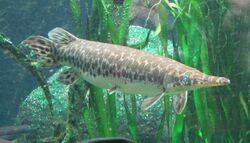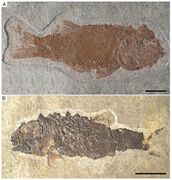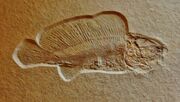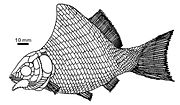Biology:Ginglymodi
| Ginglymodi | |
|---|---|

| |
| Spotted gar (Lepisosteus oculatus) | |

| |
| Macrosemimimus fegerti (Semionotiformes) from the Upper Jurassic of Germany | |
| Scientific classification | |
| Domain: | Eukaryota |
| Kingdom: | Animalia |
| Phylum: | Chordata |
| Class: | Actinopterygii |
| Infraclass: | Holostei |
| Clade: | Ginglymodi Cope, 1871 |
| Subgroups | |
| |
Ginglymodi is a clade of ray-finned fish containing modern-day gars (Lepisosteidae) & their extinct relatives (including the family Lepidotidae) in the order Lepisosteiformes, the extinct orders Semionotiformes and Kyphosichthyiformes, and various other extinct taxa. Ginglymodi is one of the two major subgroups of the infraclass Holostei, the other one being Halecomorphi, which contains the bowfin and eyespot bowfin and their fossil relatives.[1][2]
Fossil record
The fossil record of ginglymodians goes back at least to the Anisian stage of the Triassic period, over 240 million years ago.[3] Eosemionotus is one of the earliest ginglymodians. Acentrophorus, another taxon from the Wuchiapingian stage of the late Permian, and Paracentrophorus from the Early Triassic epoch, could be even earlier members of the group. Ginglymodi was diverse and widespread during the Mesozoic era, but they represent a depauperate lineage today. The group first evolved in marine environments, but several lineages made separate transitions into freshwater environments.[4] The basal ginglymodian order Kyphosichthyiformes is known from a few genera from the Triassic of China, many of which have deep bodies.[5]
Ginglymodi underwent substantial diversification during the Late Triassic and the Late Jurassic, with the Lepisosteiformes and Semionotiformes having likely diverged during the Middle Triassic.[6] Early non-gar ginglymodians of all groups, but especially early lepisosteiforms, show heavy morphological convergence with modern cypriniforms (carp and relatives), suggesting that they may have had a similar ecological niche. Notably, molecular evidence suggests that the cypriniforms may have originated and diversified around the same time and place (Late Jurassic and Early Cretaceous Southeast Asia) that the similar freshwater ginglymodians showed major diversification.[7] Eventually, some ginglymodians evolved a more predatory lifestyle, with the earliest known true gars from the Late Jurassic.[8] Ginglymodians underwent a major decline during the mid-Cretaceous, eventually leaving gars as the only surviving members of the group.[6] Gar fossils have been found on all continents except Australia and Antarctica. Only seven species exist today, distributed in the freshwater systems of North America.[8]
The Middle Triassic Ticinolepis
The Jurassic macrosemiid semionotiform Propterus sp.
The Jurassic macrosemiid semionotiform Macrosemius rostratus
The Late Jurassic European lepidotid lepisosteiform Scheenstia maxima
The basal ginglymodian Kyphosichthys (Kyphosichthyiformes) from the Middle Triassic of China
Luoxiongichthys, a basal ginglymodian (Kyphosichthyiformes) from the Middle Triassic of China
Phylogeny
Phylogenetic relationships of Ginglymodi to other living neopterygian fish.
| Neopterygii |
| ||||||||||||
Phylogenetic relationships among different groups of ginglymodians (cladogram after Xu & Ma 2023):[9]
| Ginglymodi |
| |||||||||||||||||||||||||||||||||||||||||||||
References
- ↑ 1.0 1.1 López-Arbarello, A.; Sferco, E. (2018). "Neopterygian phylogeny: the merger assay". Royal Society Open Science 5 (3): 172337. doi:10.1098/rsos.172337. PMID 29657820. Bibcode: 2018RSOS....572337L.
- ↑ Nelson, Joseph S. (2016). Fishes of the World. John Wiley & Sons, Inc. ISBN 978-1-118-34233-6.
- ↑ Romano, Carlo (2021). "A Hiatus Obscures the Early Evolution of Modern Lineages of Bony Fishes". Frontiers in Earth Science 8: 672. doi:10.3389/feart.2020.618853. ISSN 2296-6463.
- ↑ Cavin, Lionel; Deesri, Uthumporn; Olive, Sébastien (2019-07-22). "Scheenstia bernissartensis (Actinopterygii: Ginglymodi) from the Early Cretaceous of Bernissart, Belgium, with an appraisal of ginglymodian evolutionary history". Journal of Systematic Palaeontology 18 (6): 513–527. doi:10.1080/14772019.2019.1634649. ISSN 1477-2019. http://dx.doi.org/10.1080/14772019.2019.1634649.
- ↑ Xu, G.; Ma, X.; Wu, F.; Ren, Y. (2019). "A Middle Triassic kyphosichthyiform from Yunnan, China, and phylogenetic reassessment of early ginglymodians". Vertebrata PalAsiatica 57 (3): 181–204. doi:10.19615/j.cnki.1000-3118.190319. https://www.researchgate.net/publication/334308274.
- ↑ 6.0 6.1 Cawley, John J.; Marramà, Giuseppe; Carnevale, Giorgio; Villafaña, Jaime A.; López‐Romero, Faviel A.; Kriwet, Jürgen (February 2021). "Rise and fall of †Pycnodontiformes: Diversity, competition and extinction of a successful fish clade" (in en). Ecology and Evolution 11 (4): 1769–1796. doi:10.1002/ece3.7168. ISSN 2045-7758. PMID 33614003.
- ↑ Deesri, Uthumporn; Jintasakul, Pratueng; Cavin, Lionel (2016-10-07). "A new Ginglymodi (Actinopterygii, Holostei) from the Late Jurassic–Early Cretaceous of Thailand, with comments on the early diversification of Lepisosteiformes in Southeast Asia". Journal of Vertebrate Paleontology 36 (6): e1225747. doi:10.1080/02724634.2016.1225747. ISSN 0272-4634. http://dx.doi.org/10.1080/02724634.2016.1225747.
- ↑ 8.0 8.1 Paulo M. Brito; Jésus Alvarado-Ortega; François J. Meunier (2017). "Earliest known lepisosteoid extends the range of anatomically modern gars to the Late Jurassic". Scientific Reports 7 (1): Article number 17830. doi:10.1038/s41598-017-17984-w. PMID 29259200. Bibcode: 2017NatSR...717830B.
- ↑ Xu, Guang-Hui; Ma, Xin-Ying (2023-10-16). "A new basal ginglymodian fish (Holostei: Neopterygii) from the Middle Triassic (Anisian) Luoping Biota, Yunnan, China" (in en). Zoological Journal of the Linnean Society. doi:10.1093/zoolinnean/zlad144. ISSN 0024-4082. https://academic.oup.com/zoolinnean/advance-article/doi/10.1093/zoolinnean/zlad144/7319190.
Wikidata ☰ Q1525014 entry
 |








